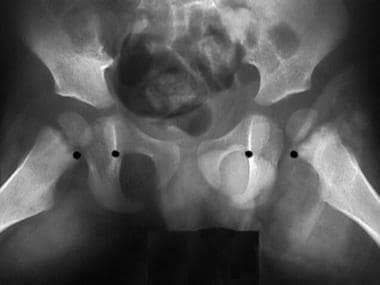Practice Essentials
Transient synovitis (TS) is the most common cause of acute hip pain in children aged 3-10 years. [1] The disease causes arthralgia and arthritis secondary to a transient inflammation of the synovium of the hip. (See the image below.)
 Widening of the joint space. Note that the space is wider on the left side. Discrepancies greater than 1 mm indicate the presence of fluid.
Widening of the joint space. Note that the space is wider on the left side. Discrepancies greater than 1 mm indicate the presence of fluid.
Signs and symptoms
Unilateral hip or groin pain is the most common symptom reported; however, some patients with transient synovitis may report medial thigh or knee pain. Very young children may have no symptoms other than crying at night, although a careful examination should reveal some degree of an antalgic limp.
Children with transient synovitis are usually afebrile or have a mildly elevated temperature; high fever is rare.
See Presentation for more detail.
Diagnosis
Laboratory studies
The following studies may be indicated in transient synovitis:
-
Complete blood cell (CBC) count
-
Erythrocyte sedimentation rate (ESR)
-
C-reactive protein measurement
-
Urinalysis and culture
Imaging studies
Radiographs exclude bony lesions unless the child had onset of symptoms within 3 days, has no fever, appears well, and has only mildly restricted abduction without guarding against movement in other planes.
Although extremely accurate for detecting an intracapsular effusion, ultrasonography does not assist in determining the cause and is used best to guide hip aspiration.
In settings in which routine aspiration of effusions is not performed, a magnetic resonance imaging (MRI) scan may help differentiate transient synovitis from septic arthritis.
See Workup for more detail.
Management
Apply heat and massage to patients with transient synovitis. If the diagnosis is equivocal or the patient is uncomfortable, hospitalize for observation and traction.
Nonsteroidal anti-inflammatory drugs (NSAIDs), such as ibuprofen and naproxen, may shorten the duration of symptoms.
See Treatment and Medication for more detail.
Patient education
Advise parents and/or caregivers to initially check the temperature of the patient with transient synovitis regularly and inform the physician of any fever.
Pathophysiology and Etiology
Pathophysiology
Biopsy reveals only nonspecific inflammation and hypertrophy of the synovial membrane. Ultrasonography demonstrates an effusion that causes bulging of the anterior joint capsule. Synovial fluid has increased proteoglycans.
Etiology
No definitive cause of transient synovitis is known, although the following have been suggested:
-
Patients with transient synovitis often have histories of trauma, which may be a cause or predisposing factor.
-
One study found an increase in viral antibody titers in 67 of 80 patients with transient synovitis.
-
Postvaccine or drug-mediated reactions and an allergic disposition have been cited as possible causes.
Epidemiology
United States statistics
Little data are available regarding the frequency of this illness. However, excluding infections and trauma, transient synovitis is one of the most common causes of joint pain in the pediatric age group. In 80-85% of children who present with a limp in the absence of trauma, transient synovitis of the hip is the cause. [2]
International statistics
The Netherlands report an incidence of 76.2 per 100,000 person-years. An Australian study found that the most common diagnosis in children who presented to the emergency department with a nontraumatic limp was transient synovitis (37%). [3]
Sex- and age-related demographics
Transient synovitis affects boys twice as often as girls.
Transient synovitis most frequently occurs in children aged 4-10 years [4] ; however, transient synovitis has been reported in a 3-month-old infant and in adults. Nonetheless, children outside the typical age group are unlikely to have transient synovitis. Some teenagers with enthesitis-associated arthritis are initially diagnosed erroneously with toxic synovitis when they first present with hip pain.
Prognosis
Patients with transient synovitis usually experience marked improvement within 24-48 hours. Two thirds to three fourths of patients with transient synovitis have complete resolution within 2 weeks. The remainder may have less severe symptoms for several weeks. The recurrence rate is 4-17%; most recurrences develop within 6 months. No increased risk of juvenile chronic arthritis is known; however, a slightly increased risk for later development of osteoarthritis may be noted.
Morbidity/mortality
The possible etiologic relationship between transient synovitis and Legg-Calvé-Perthes disease (LCP) is controversial. [5] Although some children with transient synovitis may develop LCP, whether persistence of increased intraarticular pressure eventually causes avascular necrosis or whether patients may have a synovitis that occurs before detection of femoral head collapse is not fully known. Approximately 1.5% of patients with transient synovitis develop LCP, Coxa magna, osteoarthritis, or recurrences.
Complications
Sequelae include coxa magna and mild degenerative changes of the femoral neck. Coxa magna is observed radiographically as an overgrowth of the femoral head and broadening of the femoral neck. Coxa magna leads to dysplasia of the acetabular roof and subluxation. An incidence rate of coxa magna of 32.1% has been reported in the first year following transient synovitis.
LCP disease develops in 1-3% of individuals with transient synovitis.
-
Widening of the joint space. Note that the space is wider on the left side. Discrepancies greater than 1 mm indicate the presence of fluid.







